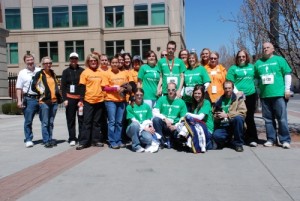The Importance of a Volunteer Strategy
Friday, July 23rd, 2010 Every non profit organization (NPO) needs a volunteer strategy. Whether it’s for recruiting board members or office helpers, a plan is essential to finding, retaining, and training volunteers. And, it can make the volunteer manager or executive director’s job much easier!
Every non profit organization (NPO) needs a volunteer strategy. Whether it’s for recruiting board members or office helpers, a plan is essential to finding, retaining, and training volunteers. And, it can make the volunteer manager or executive director’s job much easier!
Why should NPOs have a volunteer strategy?
Volunteer strategies allow volunteer programs to run more smoothly. Planning is the first step to any successful endeavor. If your NPO is embarking on a volunteer program without a plan, it could fail, putting the entire organization further behind on its goals.
- They make recruiting volunteers much easier. A volunteer strategy should identify the best-fit volunteers for the organization, including demographic information (age, gender, occupation, residence, etc.), level of involvement and needed skills. Once the various groups of potential volunteers are identified, it is much easier to find them, reach them, and recruit them.
- To help focus orientation and training efforts: A well-trained volunteer is a better volunteer. Defining roles, supplying job descriptions, and identifying staff or volunteer trainers is essential to properly orienting and training volunteers. How can training be accomplished correctly—and replicated—without planning?
- To keep volunteers engaged and help avoid burnout. Another important aspect to volunteer strategy is retention. It’s usually not a good idea to recruit volunteers and then ignore them. Keeping them interested in the mission of the NPO, demonstrating appreciation, and soliciting their feedback are all vital pieces to the retention puzzle. And there are many more—which should be explored when creating a volunteer strategy.
- To enable NPOs to develop leaders out of volunteers. If an NPO’s executive or volunteer director is not focused on the volunteer strategy, there is a huge potential for loss, both in the simple numbers of volunteers (who are not being successfully retained) and in the loss of potential leadership. When a strategy has been established, everyone is more focused. Seeing the leadership qualities in volunteers becomes an everyday thing. And those who could help take the NPO closer to its goals will not fall by the wayside, unnoticed and underappreciated.
Every businessperson knows the importance of planning for the future and strategizing on how to get there. The non profit sector can take this page out of the business playbook and use it to successfully run volunteer programs!

 Executive Directors of nonprofit organizations (NPOs) wear many hats—especially these days, when budgets are tight and staff is scarcer than ever.
Executive Directors of nonprofit organizations (NPOs) wear many hats—especially these days, when budgets are tight and staff is scarcer than ever.
 As if charities needed another one, a change in the estate tax could prove to be a possible roadblock to fundraising.
As if charities needed another one, a change in the estate tax could prove to be a possible roadblock to fundraising. Nonprofit volunteer managers are sometimes inundated with offers from corporations—especially around volunteer “holidays” like The National Day of Service and Martin Luther King, Jr. Day. While no NPOs we know would turn down volunteers who are willing and qualified to help, sometimes too much of a good thing can make for headaches.
Nonprofit volunteer managers are sometimes inundated with offers from corporations—especially around volunteer “holidays” like The National Day of Service and Martin Luther King, Jr. Day. While no NPOs we know would turn down volunteers who are willing and qualified to help, sometimes too much of a good thing can make for headaches. Budget cuts at the state and local levels are having a huge adverse effect on nonprofits all over the country. Couple budget cuts with the reality that grant makers expect to give fewer grants in 2010, and you have a recipe for another difficult year for nonprofits.
Budget cuts at the state and local levels are having a huge adverse effect on nonprofits all over the country. Couple budget cuts with the reality that grant makers expect to give fewer grants in 2010, and you have a recipe for another difficult year for nonprofits. The recession has been extremely difficult on charitable organizations, and many have not survived. To avoid shutting their doors, many are opening their minds to new possibilities—also known as “survival tactics.” Reports show that increasingly, nonprofits around the country are turning to collaborations, partnerships, and mergers.
The recession has been extremely difficult on charitable organizations, and many have not survived. To avoid shutting their doors, many are opening their minds to new possibilities—also known as “survival tactics.” Reports show that increasingly, nonprofits around the country are turning to collaborations, partnerships, and mergers. The top ten rated U.S. cites for volunteering are: Minneapolis-St. Paul, MN; Portland, OR; Salt Lake City, UT; Seattle, WA; Kansas City, MO; Columbus, OH; Oklahoma City, OK; Hartford, CT; Denver, CO; and Washington, DC.
The top ten rated U.S. cites for volunteering are: Minneapolis-St. Paul, MN; Portland, OR; Salt Lake City, UT; Seattle, WA; Kansas City, MO; Columbus, OH; Oklahoma City, OK; Hartford, CT; Denver, CO; and Washington, DC. Volunteering appears to prove the saying, “’tis better to give than to receive.” While most volunteers’ intentions are solely to help others, researchers say that the benefits to the volunteers are also numerous.
Volunteering appears to prove the saying, “’tis better to give than to receive.” While most volunteers’ intentions are solely to help others, researchers say that the benefits to the volunteers are also numerous.